Effective Teaching Approaches for Gifted Children in Early Childhood
VerifiedAdded on 2022/11/24
|8
|2352
|166
Essay
AI Summary
This essay examines various teaching strategies and approaches for gifted children in early childhood education, focusing on the unique needs of these learners. It explores the misconceptions surrounding giftedness and emphasizes the importance of recognizing and responding to the advanced learning capacities of young children. The essay delves into specific strategies, including the implementation of the Malaguzzi (Reggio) approach, differentiated instruction, and the importance of creating a stimulating learning environment. It also addresses the need for educators to support gifted children from disadvantaged backgrounds by providing opportunities for identification, implementing inclusive classroom practices, and tailoring instruction to meet their diverse interests and needs. The essay further outlines beneficial pedagogical practices, such as differentiated instruction and Response to Intervention, to enhance the quality of gifted education and foster independent thinking and innovative skills. The student emphasizes the importance of teacher-parent collaboration, curriculum modification, and continuous assessment in supporting the development of gifted children.
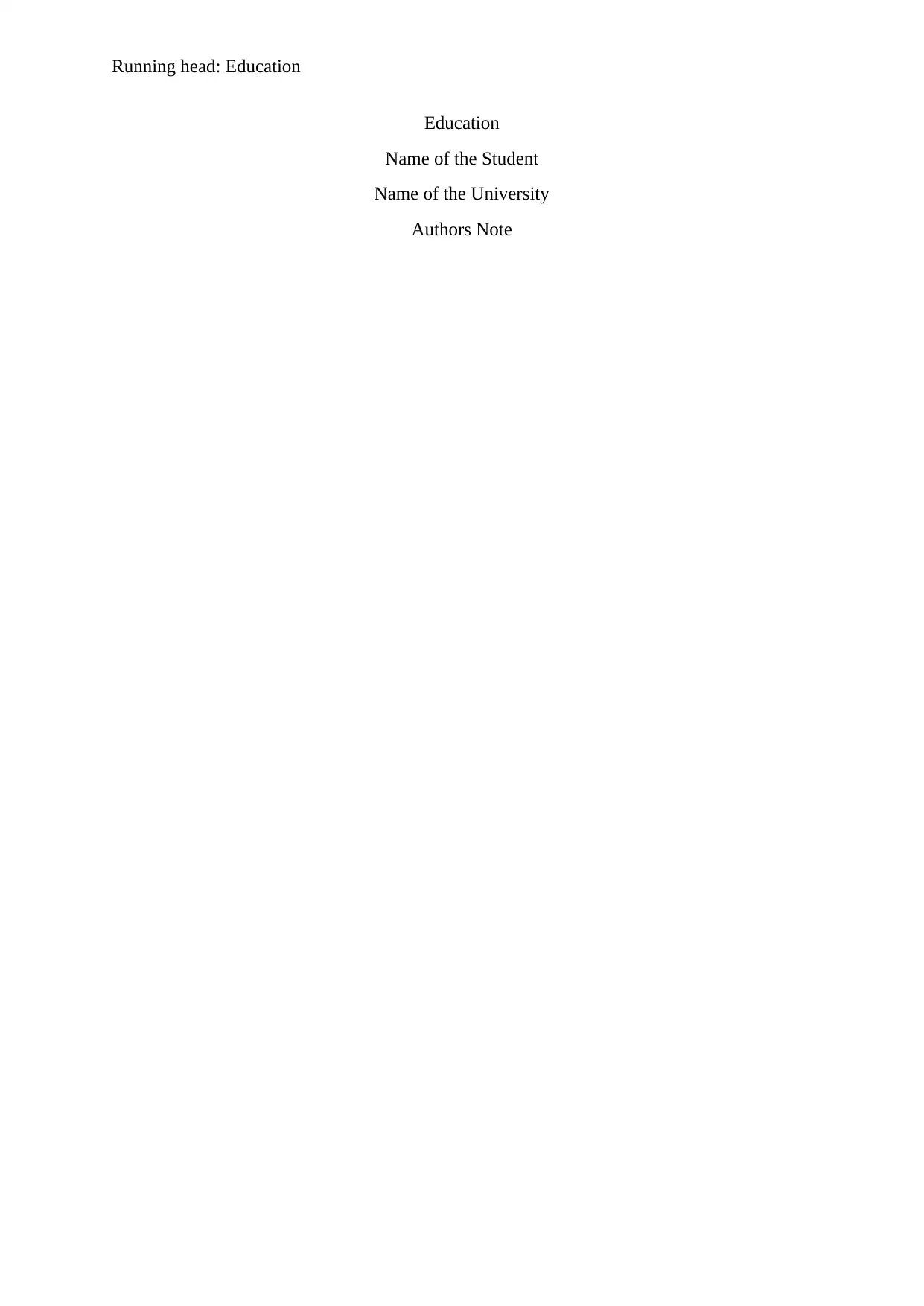
Running head: Education
Education
Name of the Student
Name of the University
Authors Note
Education
Name of the Student
Name of the University
Authors Note
Paraphrase This Document
Need a fresh take? Get an instant paraphrase of this document with our AI Paraphraser
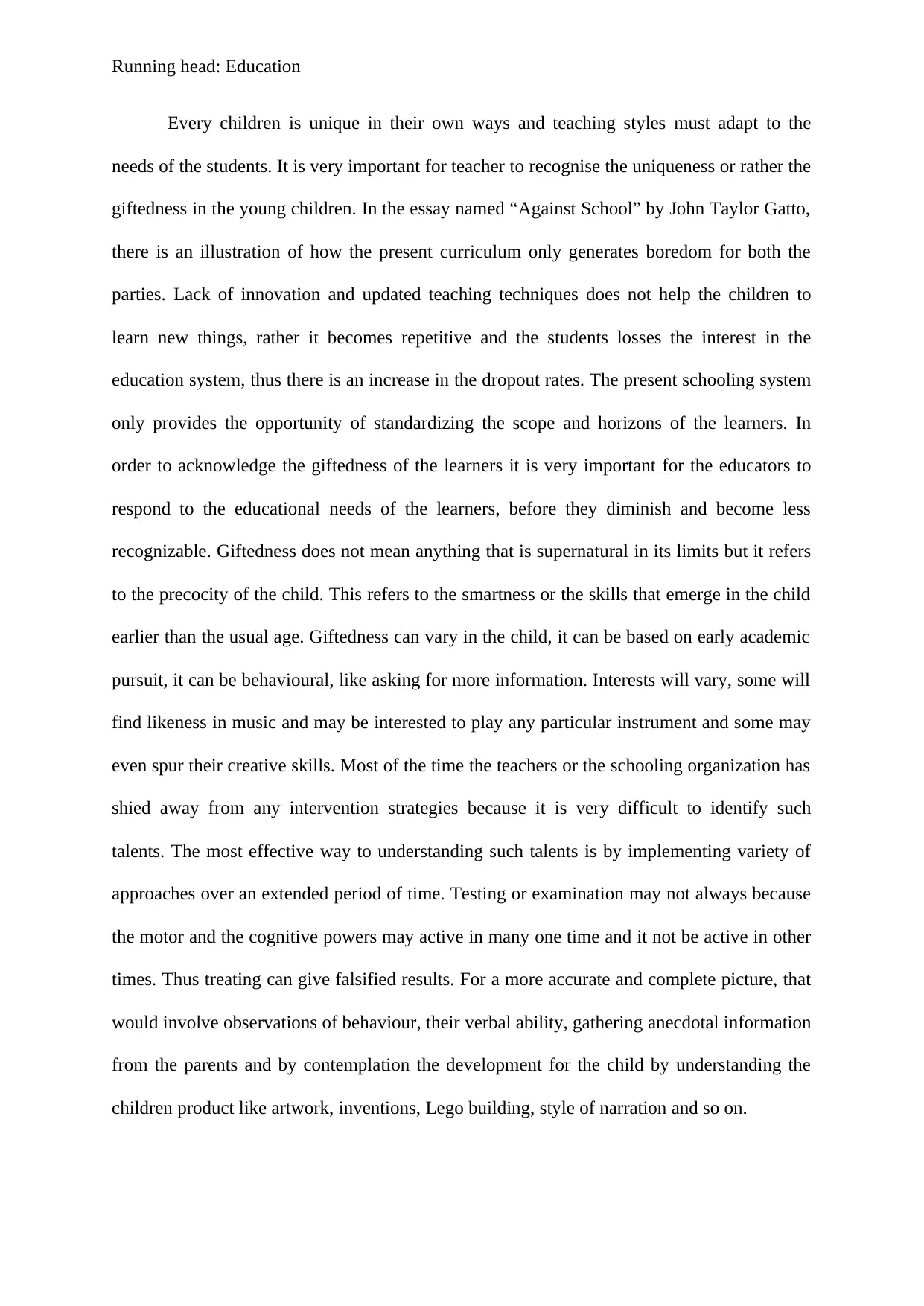
Running head: Education
Every children is unique in their own ways and teaching styles must adapt to the
needs of the students. It is very important for teacher to recognise the uniqueness or rather the
giftedness in the young children. In the essay named “Against School” by John Taylor Gatto,
there is an illustration of how the present curriculum only generates boredom for both the
parties. Lack of innovation and updated teaching techniques does not help the children to
learn new things, rather it becomes repetitive and the students losses the interest in the
education system, thus there is an increase in the dropout rates. The present schooling system
only provides the opportunity of standardizing the scope and horizons of the learners. In
order to acknowledge the giftedness of the learners it is very important for the educators to
respond to the educational needs of the learners, before they diminish and become less
recognizable. Giftedness does not mean anything that is supernatural in its limits but it refers
to the precocity of the child. This refers to the smartness or the skills that emerge in the child
earlier than the usual age. Giftedness can vary in the child, it can be based on early academic
pursuit, it can be behavioural, like asking for more information. Interests will vary, some will
find likeness in music and may be interested to play any particular instrument and some may
even spur their creative skills. Most of the time the teachers or the schooling organization has
shied away from any intervention strategies because it is very difficult to identify such
talents. The most effective way to understanding such talents is by implementing variety of
approaches over an extended period of time. Testing or examination may not always because
the motor and the cognitive powers may active in many one time and it not be active in other
times. Thus treating can give falsified results. For a more accurate and complete picture, that
would involve observations of behaviour, their verbal ability, gathering anecdotal information
from the parents and by contemplation the development for the child by understanding the
children product like artwork, inventions, Lego building, style of narration and so on.
Every children is unique in their own ways and teaching styles must adapt to the
needs of the students. It is very important for teacher to recognise the uniqueness or rather the
giftedness in the young children. In the essay named “Against School” by John Taylor Gatto,
there is an illustration of how the present curriculum only generates boredom for both the
parties. Lack of innovation and updated teaching techniques does not help the children to
learn new things, rather it becomes repetitive and the students losses the interest in the
education system, thus there is an increase in the dropout rates. The present schooling system
only provides the opportunity of standardizing the scope and horizons of the learners. In
order to acknowledge the giftedness of the learners it is very important for the educators to
respond to the educational needs of the learners, before they diminish and become less
recognizable. Giftedness does not mean anything that is supernatural in its limits but it refers
to the precocity of the child. This refers to the smartness or the skills that emerge in the child
earlier than the usual age. Giftedness can vary in the child, it can be based on early academic
pursuit, it can be behavioural, like asking for more information. Interests will vary, some will
find likeness in music and may be interested to play any particular instrument and some may
even spur their creative skills. Most of the time the teachers or the schooling organization has
shied away from any intervention strategies because it is very difficult to identify such
talents. The most effective way to understanding such talents is by implementing variety of
approaches over an extended period of time. Testing or examination may not always because
the motor and the cognitive powers may active in many one time and it not be active in other
times. Thus treating can give falsified results. For a more accurate and complete picture, that
would involve observations of behaviour, their verbal ability, gathering anecdotal information
from the parents and by contemplation the development for the child by understanding the
children product like artwork, inventions, Lego building, style of narration and so on.
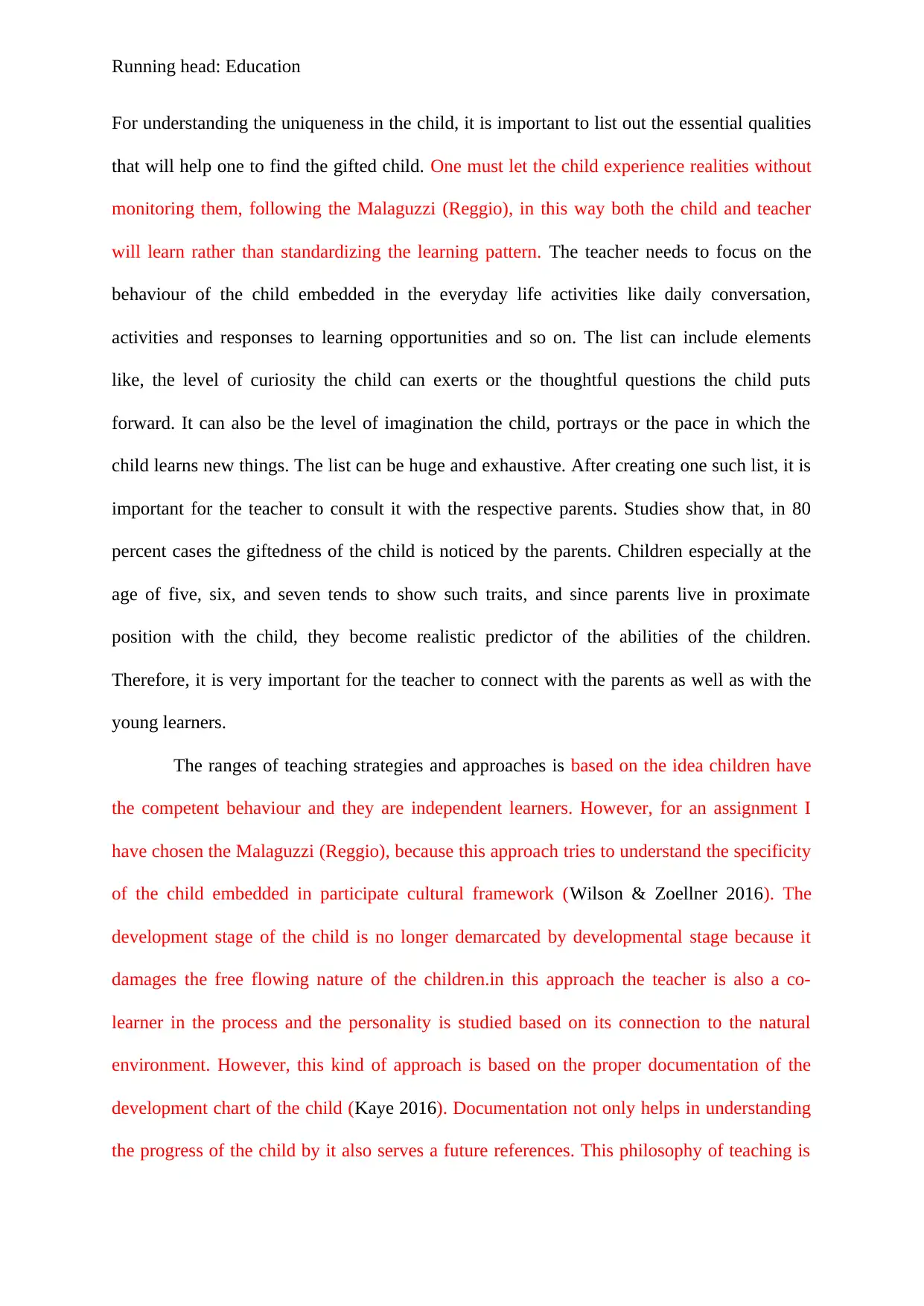
Running head: Education
For understanding the uniqueness in the child, it is important to list out the essential qualities
that will help one to find the gifted child. One must let the child experience realities without
monitoring them, following the Malaguzzi (Reggio), in this way both the child and teacher
will learn rather than standardizing the learning pattern. The teacher needs to focus on the
behaviour of the child embedded in the everyday life activities like daily conversation,
activities and responses to learning opportunities and so on. The list can include elements
like, the level of curiosity the child can exerts or the thoughtful questions the child puts
forward. It can also be the level of imagination the child, portrays or the pace in which the
child learns new things. The list can be huge and exhaustive. After creating one such list, it is
important for the teacher to consult it with the respective parents. Studies show that, in 80
percent cases the giftedness of the child is noticed by the parents. Children especially at the
age of five, six, and seven tends to show such traits, and since parents live in proximate
position with the child, they become realistic predictor of the abilities of the children.
Therefore, it is very important for the teacher to connect with the parents as well as with the
young learners.
The ranges of teaching strategies and approaches is based on the idea children have
the competent behaviour and they are independent learners. However, for an assignment I
have chosen the Malaguzzi (Reggio), because this approach tries to understand the specificity
of the child embedded in participate cultural framework (Wilson & Zoellner 2016). The
development stage of the child is no longer demarcated by developmental stage because it
damages the free flowing nature of the children.in this approach the teacher is also a co-
learner in the process and the personality is studied based on its connection to the natural
environment. However, this kind of approach is based on the proper documentation of the
development chart of the child (Kaye 2016). Documentation not only helps in understanding
the progress of the child by it also serves a future references. This philosophy of teaching is
For understanding the uniqueness in the child, it is important to list out the essential qualities
that will help one to find the gifted child. One must let the child experience realities without
monitoring them, following the Malaguzzi (Reggio), in this way both the child and teacher
will learn rather than standardizing the learning pattern. The teacher needs to focus on the
behaviour of the child embedded in the everyday life activities like daily conversation,
activities and responses to learning opportunities and so on. The list can include elements
like, the level of curiosity the child can exerts or the thoughtful questions the child puts
forward. It can also be the level of imagination the child, portrays or the pace in which the
child learns new things. The list can be huge and exhaustive. After creating one such list, it is
important for the teacher to consult it with the respective parents. Studies show that, in 80
percent cases the giftedness of the child is noticed by the parents. Children especially at the
age of five, six, and seven tends to show such traits, and since parents live in proximate
position with the child, they become realistic predictor of the abilities of the children.
Therefore, it is very important for the teacher to connect with the parents as well as with the
young learners.
The ranges of teaching strategies and approaches is based on the idea children have
the competent behaviour and they are independent learners. However, for an assignment I
have chosen the Malaguzzi (Reggio), because this approach tries to understand the specificity
of the child embedded in participate cultural framework (Wilson & Zoellner 2016). The
development stage of the child is no longer demarcated by developmental stage because it
damages the free flowing nature of the children.in this approach the teacher is also a co-
learner in the process and the personality is studied based on its connection to the natural
environment. However, this kind of approach is based on the proper documentation of the
development chart of the child (Kaye 2016). Documentation not only helps in understanding
the progress of the child by it also serves a future references. This philosophy of teaching is
⊘ This is a preview!⊘
Do you want full access?
Subscribe today to unlock all pages.

Trusted by 1+ million students worldwide
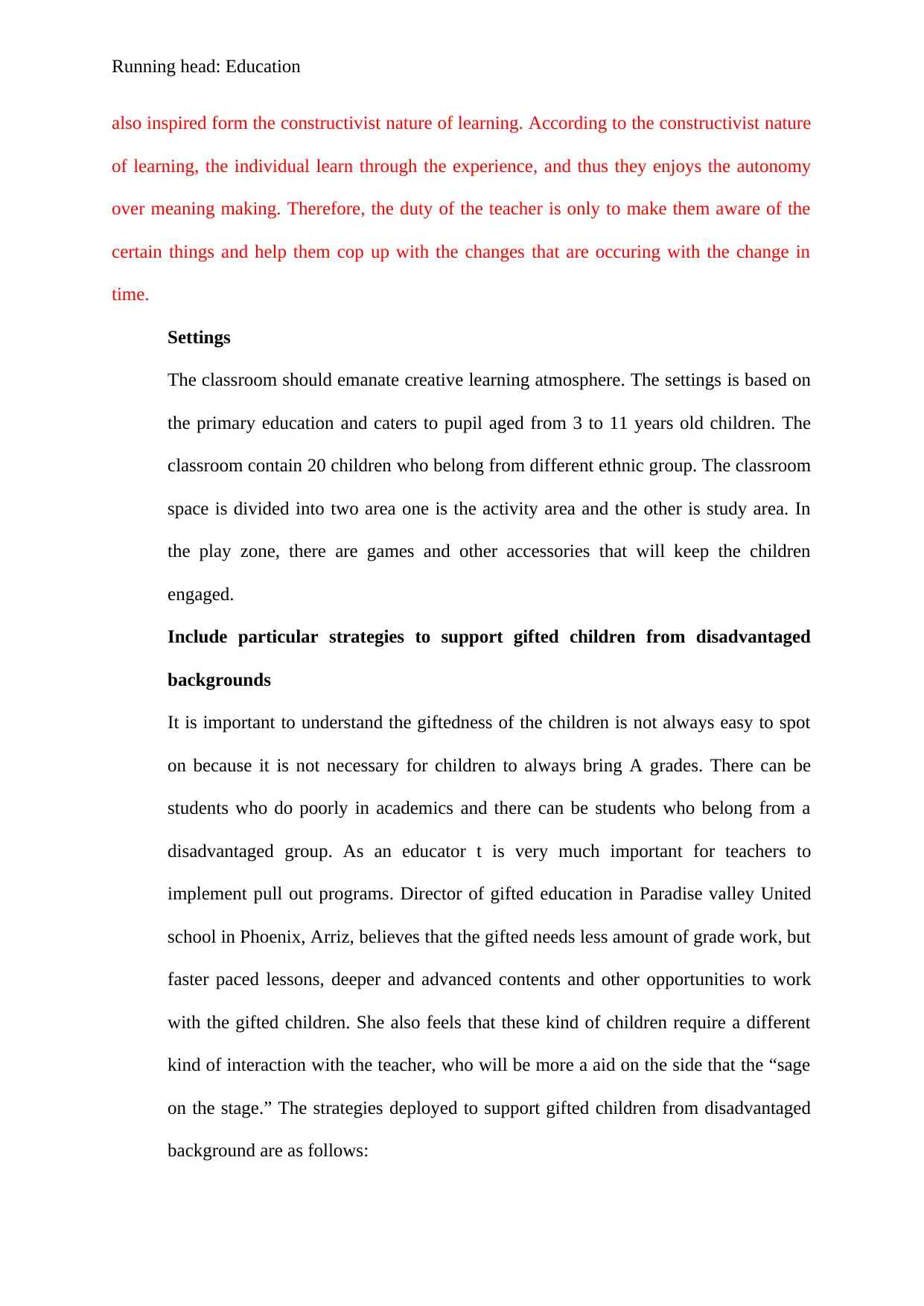
Running head: Education
also inspired form the constructivist nature of learning. According to the constructivist nature
of learning, the individual learn through the experience, and thus they enjoys the autonomy
over meaning making. Therefore, the duty of the teacher is only to make them aware of the
certain things and help them cop up with the changes that are occuring with the change in
time.
Settings
The classroom should emanate creative learning atmosphere. The settings is based on
the primary education and caters to pupil aged from 3 to 11 years old children. The
classroom contain 20 children who belong from different ethnic group. The classroom
space is divided into two area one is the activity area and the other is study area. In
the play zone, there are games and other accessories that will keep the children
engaged.
Include particular strategies to support gifted children from disadvantaged
backgrounds
It is important to understand the giftedness of the children is not always easy to spot
on because it is not necessary for children to always bring A grades. There can be
students who do poorly in academics and there can be students who belong from a
disadvantaged group. As an educator t is very much important for teachers to
implement pull out programs. Director of gifted education in Paradise valley United
school in Phoenix, Arriz, believes that the gifted needs less amount of grade work, but
faster paced lessons, deeper and advanced contents and other opportunities to work
with the gifted children. She also feels that these kind of children require a different
kind of interaction with the teacher, who will be more a aid on the side that the “sage
on the stage.” The strategies deployed to support gifted children from disadvantaged
background are as follows:
also inspired form the constructivist nature of learning. According to the constructivist nature
of learning, the individual learn through the experience, and thus they enjoys the autonomy
over meaning making. Therefore, the duty of the teacher is only to make them aware of the
certain things and help them cop up with the changes that are occuring with the change in
time.
Settings
The classroom should emanate creative learning atmosphere. The settings is based on
the primary education and caters to pupil aged from 3 to 11 years old children. The
classroom contain 20 children who belong from different ethnic group. The classroom
space is divided into two area one is the activity area and the other is study area. In
the play zone, there are games and other accessories that will keep the children
engaged.
Include particular strategies to support gifted children from disadvantaged
backgrounds
It is important to understand the giftedness of the children is not always easy to spot
on because it is not necessary for children to always bring A grades. There can be
students who do poorly in academics and there can be students who belong from a
disadvantaged group. As an educator t is very much important for teachers to
implement pull out programs. Director of gifted education in Paradise valley United
school in Phoenix, Arriz, believes that the gifted needs less amount of grade work, but
faster paced lessons, deeper and advanced contents and other opportunities to work
with the gifted children. She also feels that these kind of children require a different
kind of interaction with the teacher, who will be more a aid on the side that the “sage
on the stage.” The strategies deployed to support gifted children from disadvantaged
background are as follows:
Paraphrase This Document
Need a fresh take? Get an instant paraphrase of this document with our AI Paraphraser
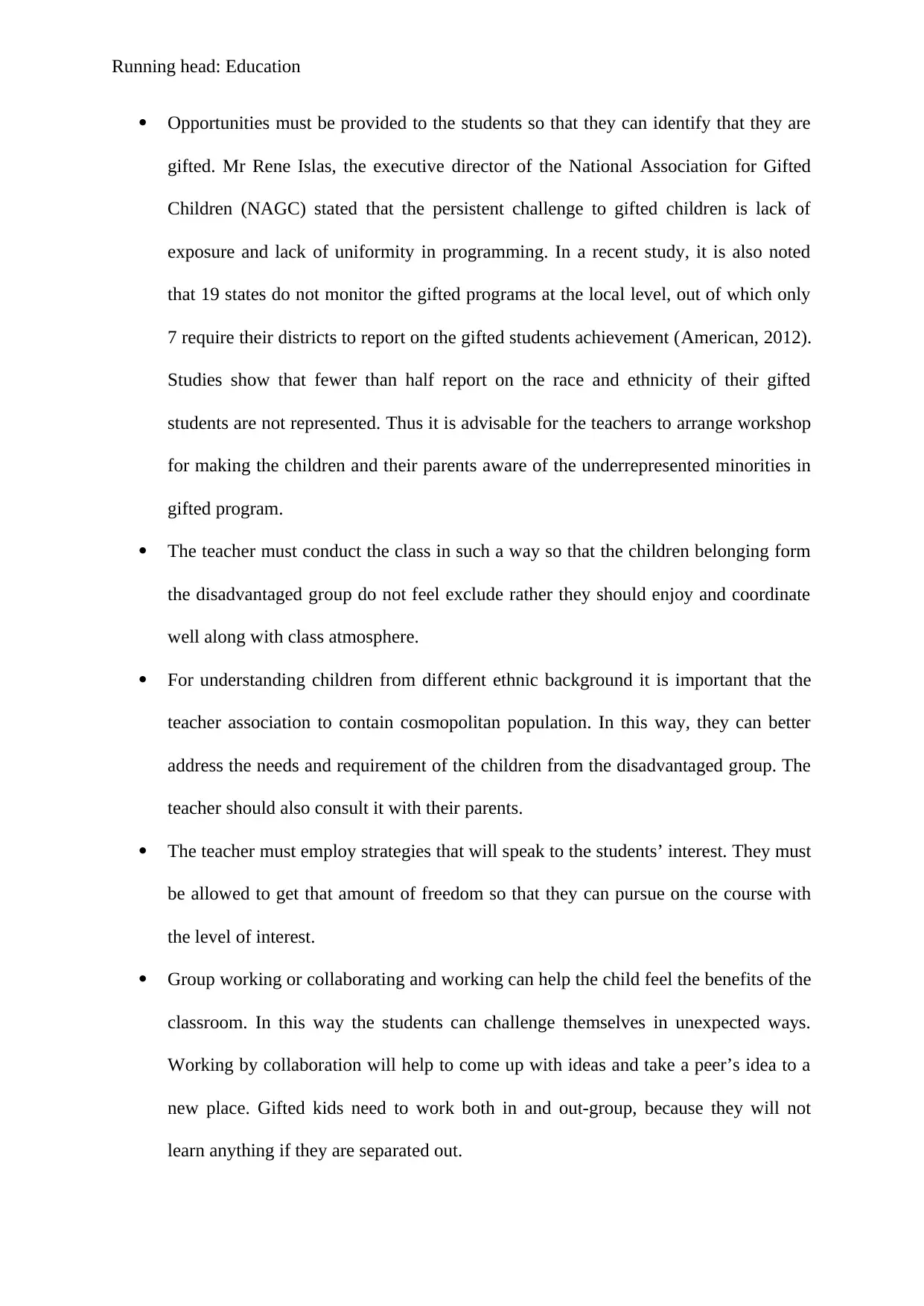
Running head: Education
Opportunities must be provided to the students so that they can identify that they are
gifted. Mr Rene Islas, the executive director of the National Association for Gifted
Children (NAGC) stated that the persistent challenge to gifted children is lack of
exposure and lack of uniformity in programming. In a recent study, it is also noted
that 19 states do not monitor the gifted programs at the local level, out of which only
7 require their districts to report on the gifted students achievement (American, 2012).
Studies show that fewer than half report on the race and ethnicity of their gifted
students are not represented. Thus it is advisable for the teachers to arrange workshop
for making the children and their parents aware of the underrepresented minorities in
gifted program.
The teacher must conduct the class in such a way so that the children belonging form
the disadvantaged group do not feel exclude rather they should enjoy and coordinate
well along with class atmosphere.
For understanding children from different ethnic background it is important that the
teacher association to contain cosmopolitan population. In this way, they can better
address the needs and requirement of the children from the disadvantaged group. The
teacher should also consult it with their parents.
The teacher must employ strategies that will speak to the students’ interest. They must
be allowed to get that amount of freedom so that they can pursue on the course with
the level of interest.
Group working or collaborating and working can help the child feel the benefits of the
classroom. In this way the students can challenge themselves in unexpected ways.
Working by collaboration will help to come up with ideas and take a peer’s idea to a
new place. Gifted kids need to work both in and out-group, because they will not
learn anything if they are separated out.
Opportunities must be provided to the students so that they can identify that they are
gifted. Mr Rene Islas, the executive director of the National Association for Gifted
Children (NAGC) stated that the persistent challenge to gifted children is lack of
exposure and lack of uniformity in programming. In a recent study, it is also noted
that 19 states do not monitor the gifted programs at the local level, out of which only
7 require their districts to report on the gifted students achievement (American, 2012).
Studies show that fewer than half report on the race and ethnicity of their gifted
students are not represented. Thus it is advisable for the teachers to arrange workshop
for making the children and their parents aware of the underrepresented minorities in
gifted program.
The teacher must conduct the class in such a way so that the children belonging form
the disadvantaged group do not feel exclude rather they should enjoy and coordinate
well along with class atmosphere.
For understanding children from different ethnic background it is important that the
teacher association to contain cosmopolitan population. In this way, they can better
address the needs and requirement of the children from the disadvantaged group. The
teacher should also consult it with their parents.
The teacher must employ strategies that will speak to the students’ interest. They must
be allowed to get that amount of freedom so that they can pursue on the course with
the level of interest.
Group working or collaborating and working can help the child feel the benefits of the
classroom. In this way the students can challenge themselves in unexpected ways.
Working by collaboration will help to come up with ideas and take a peer’s idea to a
new place. Gifted kids need to work both in and out-group, because they will not
learn anything if they are separated out.
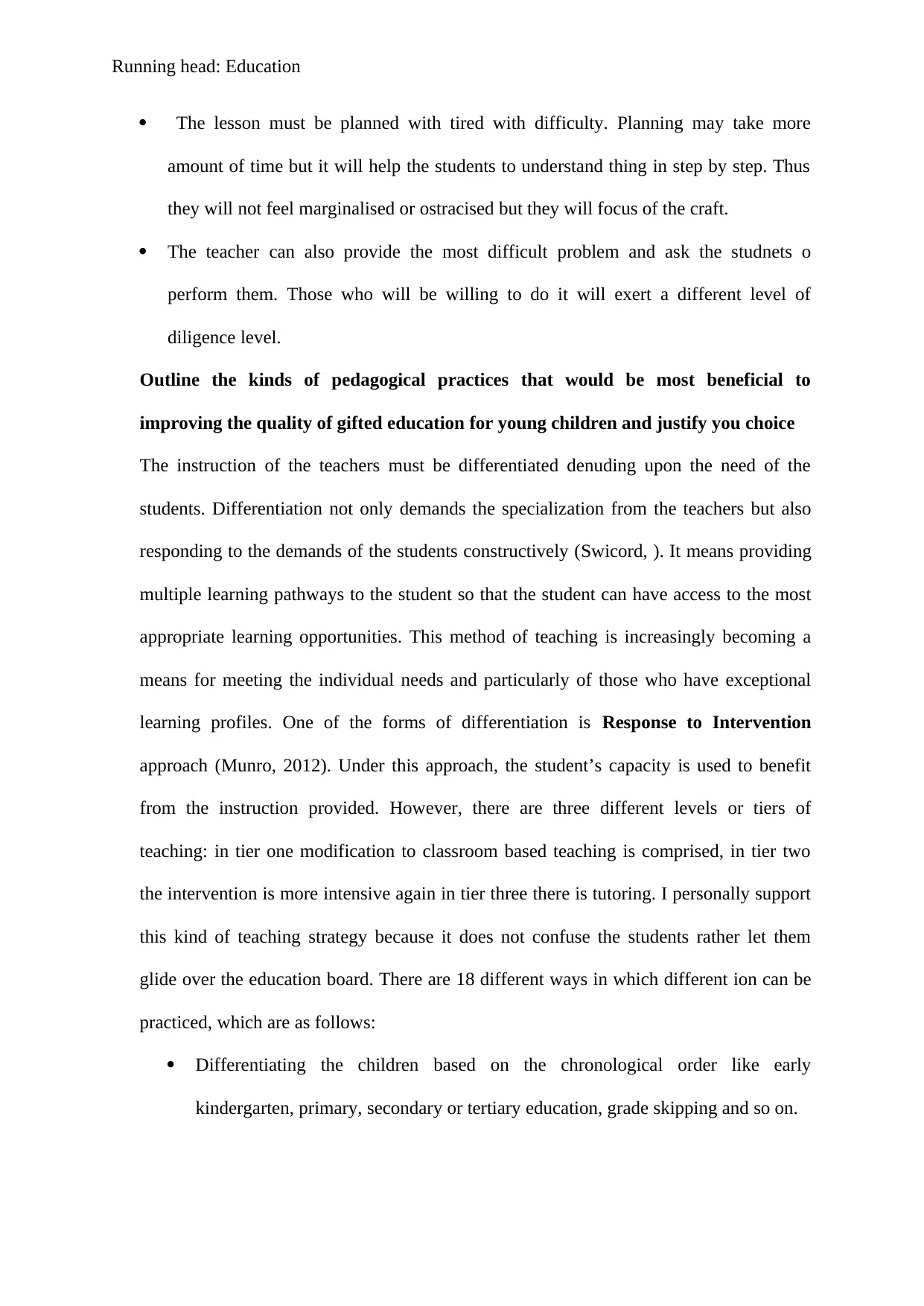
Running head: Education
The lesson must be planned with tired with difficulty. Planning may take more
amount of time but it will help the students to understand thing in step by step. Thus
they will not feel marginalised or ostracised but they will focus of the craft.
The teacher can also provide the most difficult problem and ask the studnets o
perform them. Those who will be willing to do it will exert a different level of
diligence level.
Outline the kinds of pedagogical practices that would be most beneficial to
improving the quality of gifted education for young children and justify you choice
The instruction of the teachers must be differentiated denuding upon the need of the
students. Differentiation not only demands the specialization from the teachers but also
responding to the demands of the students constructively (Swicord, ). It means providing
multiple learning pathways to the student so that the student can have access to the most
appropriate learning opportunities. This method of teaching is increasingly becoming a
means for meeting the individual needs and particularly of those who have exceptional
learning profiles. One of the forms of differentiation is Response to Intervention
approach (Munro, 2012). Under this approach, the student’s capacity is used to benefit
from the instruction provided. However, there are three different levels or tiers of
teaching: in tier one modification to classroom based teaching is comprised, in tier two
the intervention is more intensive again in tier three there is tutoring. I personally support
this kind of teaching strategy because it does not confuse the students rather let them
glide over the education board. There are 18 different ways in which different ion can be
practiced, which are as follows:
Differentiating the children based on the chronological order like early
kindergarten, primary, secondary or tertiary education, grade skipping and so on.
The lesson must be planned with tired with difficulty. Planning may take more
amount of time but it will help the students to understand thing in step by step. Thus
they will not feel marginalised or ostracised but they will focus of the craft.
The teacher can also provide the most difficult problem and ask the studnets o
perform them. Those who will be willing to do it will exert a different level of
diligence level.
Outline the kinds of pedagogical practices that would be most beneficial to
improving the quality of gifted education for young children and justify you choice
The instruction of the teachers must be differentiated denuding upon the need of the
students. Differentiation not only demands the specialization from the teachers but also
responding to the demands of the students constructively (Swicord, ). It means providing
multiple learning pathways to the student so that the student can have access to the most
appropriate learning opportunities. This method of teaching is increasingly becoming a
means for meeting the individual needs and particularly of those who have exceptional
learning profiles. One of the forms of differentiation is Response to Intervention
approach (Munro, 2012). Under this approach, the student’s capacity is used to benefit
from the instruction provided. However, there are three different levels or tiers of
teaching: in tier one modification to classroom based teaching is comprised, in tier two
the intervention is more intensive again in tier three there is tutoring. I personally support
this kind of teaching strategy because it does not confuse the students rather let them
glide over the education board. There are 18 different ways in which different ion can be
practiced, which are as follows:
Differentiating the children based on the chronological order like early
kindergarten, primary, secondary or tertiary education, grade skipping and so on.
⊘ This is a preview!⊘
Do you want full access?
Subscribe today to unlock all pages.

Trusted by 1+ million students worldwide
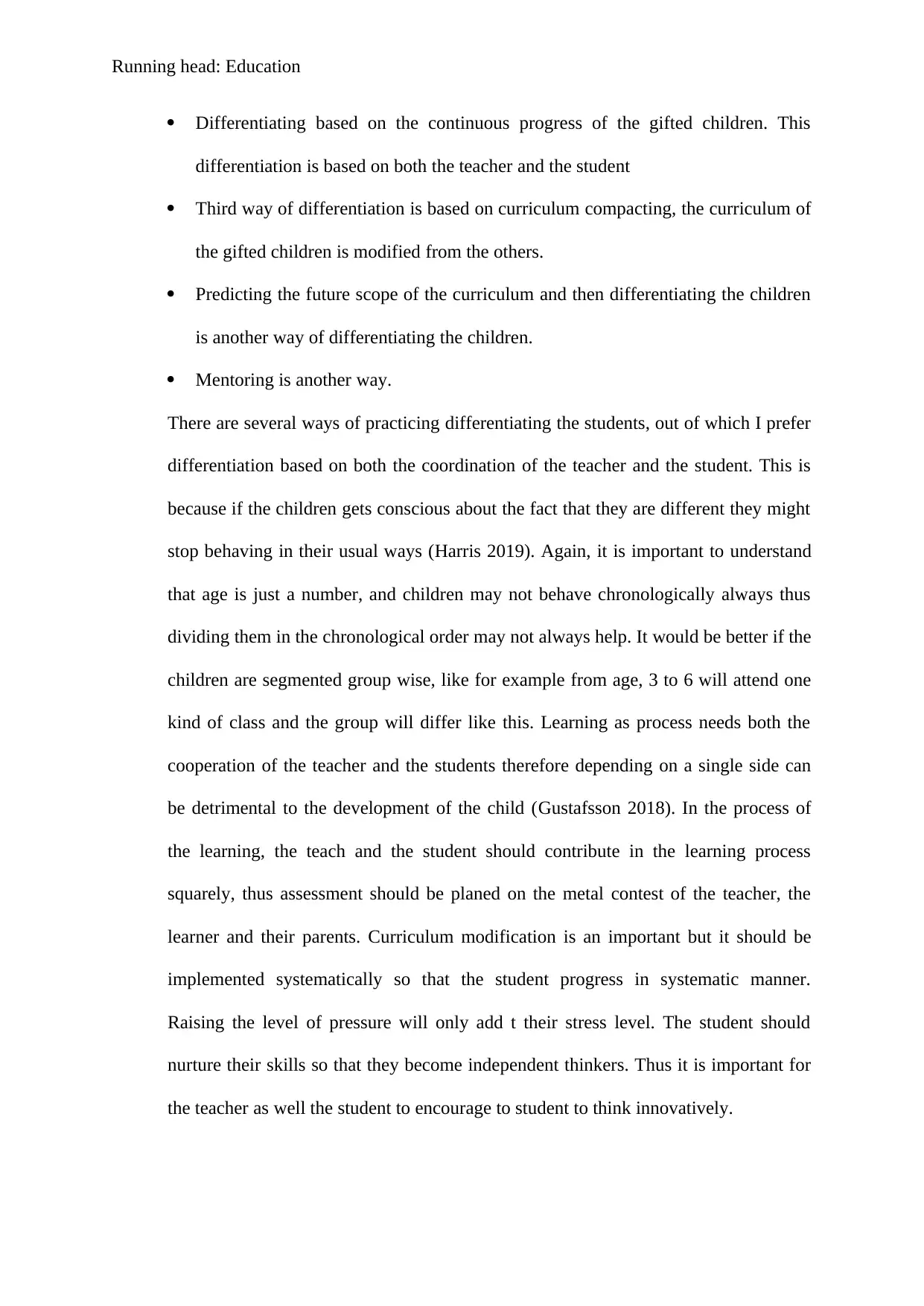
Running head: Education
Differentiating based on the continuous progress of the gifted children. This
differentiation is based on both the teacher and the student
Third way of differentiation is based on curriculum compacting, the curriculum of
the gifted children is modified from the others.
Predicting the future scope of the curriculum and then differentiating the children
is another way of differentiating the children.
Mentoring is another way.
There are several ways of practicing differentiating the students, out of which I prefer
differentiation based on both the coordination of the teacher and the student. This is
because if the children gets conscious about the fact that they are different they might
stop behaving in their usual ways (Harris 2019). Again, it is important to understand
that age is just a number, and children may not behave chronologically always thus
dividing them in the chronological order may not always help. It would be better if the
children are segmented group wise, like for example from age, 3 to 6 will attend one
kind of class and the group will differ like this. Learning as process needs both the
cooperation of the teacher and the students therefore depending on a single side can
be detrimental to the development of the child (Gustafsson 2018). In the process of
the learning, the teach and the student should contribute in the learning process
squarely, thus assessment should be planed on the metal contest of the teacher, the
learner and their parents. Curriculum modification is an important but it should be
implemented systematically so that the student progress in systematic manner.
Raising the level of pressure will only add t their stress level. The student should
nurture their skills so that they become independent thinkers. Thus it is important for
the teacher as well the student to encourage to student to think innovatively.
Differentiating based on the continuous progress of the gifted children. This
differentiation is based on both the teacher and the student
Third way of differentiation is based on curriculum compacting, the curriculum of
the gifted children is modified from the others.
Predicting the future scope of the curriculum and then differentiating the children
is another way of differentiating the children.
Mentoring is another way.
There are several ways of practicing differentiating the students, out of which I prefer
differentiation based on both the coordination of the teacher and the student. This is
because if the children gets conscious about the fact that they are different they might
stop behaving in their usual ways (Harris 2019). Again, it is important to understand
that age is just a number, and children may not behave chronologically always thus
dividing them in the chronological order may not always help. It would be better if the
children are segmented group wise, like for example from age, 3 to 6 will attend one
kind of class and the group will differ like this. Learning as process needs both the
cooperation of the teacher and the students therefore depending on a single side can
be detrimental to the development of the child (Gustafsson 2018). In the process of
the learning, the teach and the student should contribute in the learning process
squarely, thus assessment should be planed on the metal contest of the teacher, the
learner and their parents. Curriculum modification is an important but it should be
implemented systematically so that the student progress in systematic manner.
Raising the level of pressure will only add t their stress level. The student should
nurture their skills so that they become independent thinkers. Thus it is important for
the teacher as well the student to encourage to student to think innovatively.
Paraphrase This Document
Need a fresh take? Get an instant paraphrase of this document with our AI Paraphraser
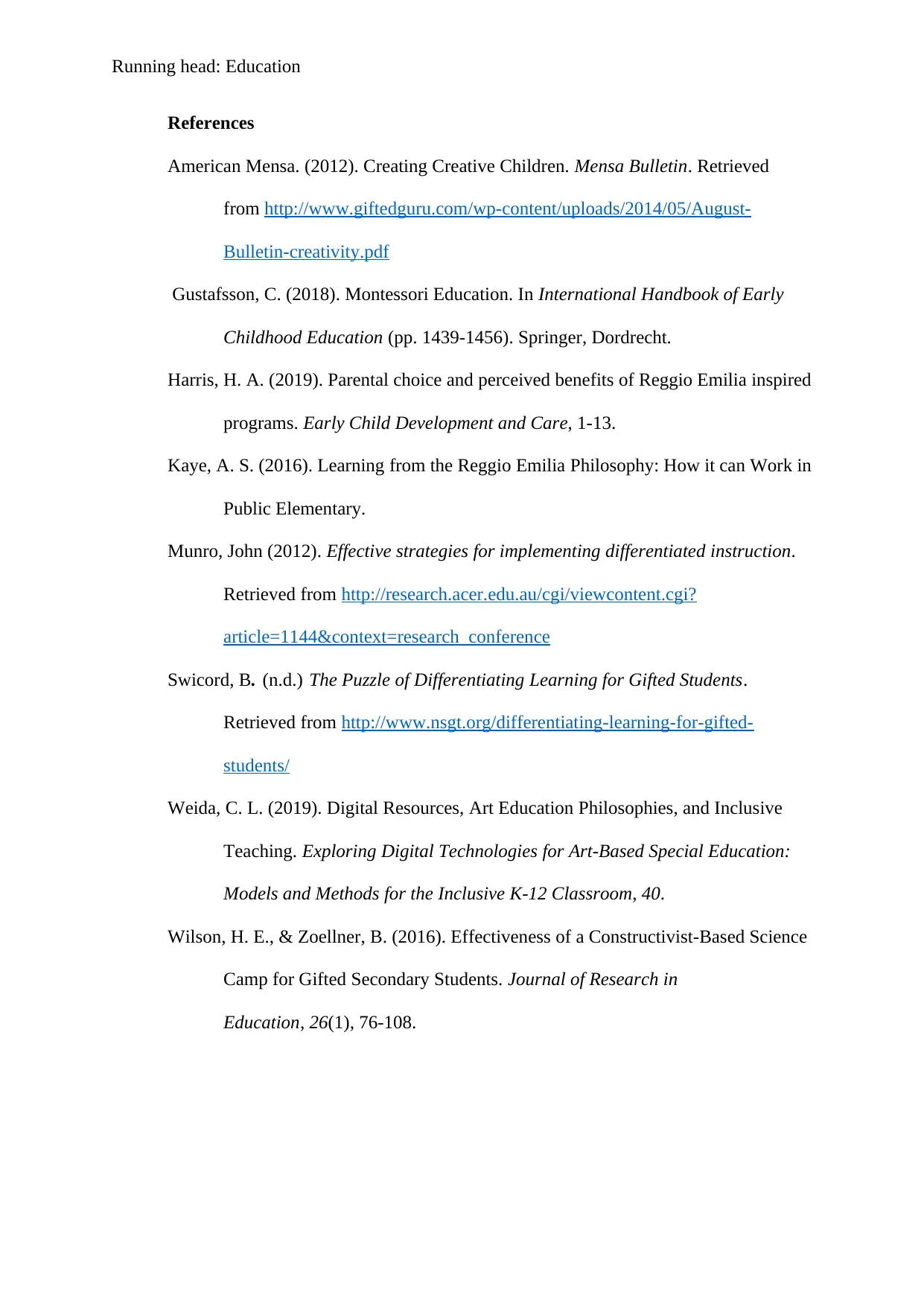
Running head: Education
References
American Mensa. (2012). Creating Creative Children. Mensa Bulletin. Retrieved
from http://www.giftedguru.com/wp-content/uploads/2014/05/August-
Bulletin-creativity.pdf
Gustafsson, C. (2018). Montessori Education. In International Handbook of Early
Childhood Education (pp. 1439-1456). Springer, Dordrecht.
Harris, H. A. (2019). Parental choice and perceived benefits of Reggio Emilia inspired
programs. Early Child Development and Care, 1-13.
Kaye, A. S. (2016). Learning from the Reggio Emilia Philosophy: How it can Work in
Public Elementary.
Munro, John (2012). Effective strategies for implementing differentiated instruction.
Retrieved from http://research.acer.edu.au/cgi/viewcontent.cgi?
article=1144&context=research_conference
Swicord, B. (n.d.) The Puzzle of Differentiating Learning for Gifted Students.
Retrieved from http://www.nsgt.org/differentiating-learning-for-gifted-
students/
Weida, C. L. (2019). Digital Resources, Art Education Philosophies, and Inclusive
Teaching. Exploring Digital Technologies for Art-Based Special Education:
Models and Methods for the Inclusive K-12 Classroom, 40.
Wilson, H. E., & Zoellner, B. (2016). Effectiveness of a Constructivist-Based Science
Camp for Gifted Secondary Students. Journal of Research in
Education, 26(1), 76-108.
References
American Mensa. (2012). Creating Creative Children. Mensa Bulletin. Retrieved
from http://www.giftedguru.com/wp-content/uploads/2014/05/August-
Bulletin-creativity.pdf
Gustafsson, C. (2018). Montessori Education. In International Handbook of Early
Childhood Education (pp. 1439-1456). Springer, Dordrecht.
Harris, H. A. (2019). Parental choice and perceived benefits of Reggio Emilia inspired
programs. Early Child Development and Care, 1-13.
Kaye, A. S. (2016). Learning from the Reggio Emilia Philosophy: How it can Work in
Public Elementary.
Munro, John (2012). Effective strategies for implementing differentiated instruction.
Retrieved from http://research.acer.edu.au/cgi/viewcontent.cgi?
article=1144&context=research_conference
Swicord, B. (n.d.) The Puzzle of Differentiating Learning for Gifted Students.
Retrieved from http://www.nsgt.org/differentiating-learning-for-gifted-
students/
Weida, C. L. (2019). Digital Resources, Art Education Philosophies, and Inclusive
Teaching. Exploring Digital Technologies for Art-Based Special Education:
Models and Methods for the Inclusive K-12 Classroom, 40.
Wilson, H. E., & Zoellner, B. (2016). Effectiveness of a Constructivist-Based Science
Camp for Gifted Secondary Students. Journal of Research in
Education, 26(1), 76-108.
1 out of 8
Related Documents
Your All-in-One AI-Powered Toolkit for Academic Success.
+13062052269
info@desklib.com
Available 24*7 on WhatsApp / Email
![[object Object]](/_next/static/media/star-bottom.7253800d.svg)
Unlock your academic potential
Copyright © 2020–2025 A2Z Services. All Rights Reserved. Developed and managed by ZUCOL.




